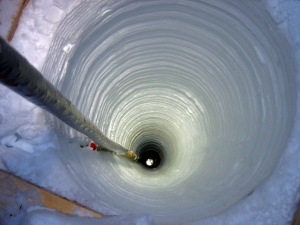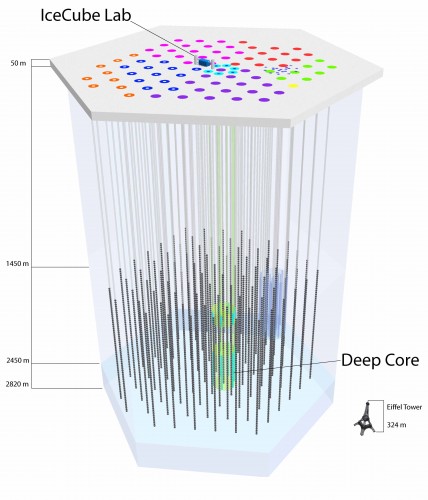 The news this past week that the IceCube Neutrino Observatory has fulfilled its mission by detecting neutrinos originating beyond the solar system reminds me of a story I once heard. I can’t reveal the source, though not out of a sense of journalistic responsibility. If anything, my discretion is due to journalistic irresponsibility: I don’t remember his name, and I wasn’t taking notes at the time. I have a good excuse, though: I was loopy.
The news this past week that the IceCube Neutrino Observatory has fulfilled its mission by detecting neutrinos originating beyond the solar system reminds me of a story I once heard. I can’t reveal the source, though not out of a sense of journalistic responsibility. If anything, my discretion is due to journalistic irresponsibility: I don’t remember his name, and I wasn’t taking notes at the time. I have a good excuse, though: I was loopy.
The IceCube experiment is part of the Amundsen-Scott South Pole Station, the United States’s scientific research outpost at the South Pole, which I visited in late December 2008 on a grant from the National Science Foundation’s Antarctic Artists and Writers program. On the day of my stop at IceCube, I was fresh off a sea-level-to-9000-foot-elevation-in-three-hours plane ride. Almost immediately upon my arrival at the Pole I had met someone working on IceCube who offered to give me a tour, and not knowing if I’d have another chance, I accepted, albeit hypoxically.
IceCube is, essentially, a telescope that points down. It covers a square kilometer of Antarctic real estate, and it consists of eighty-six “strings” that extend a mile or more into the purest ice on Earth. Each of those strings is garlanded with sixty sensors designed to observe a species of particle from space that can rip through the Earth’s atmosphere, zip through the surface on the opposite side of the planet and just keep going through crust and mantle, then through the Earth’s core, then through more mantle and crust and surface, all without interacting with anything else, at which point, in a few very occasional cases, one will smack into an atom in the ice that fills the 9000-foot vertical expanse between the surface of the Earth and the South Pole.
 In each of those cases—twenty-eight of which occurred between May 2010 and 2012, according to a paper published in the November 22 issue of Science—the interaction of a neutrino with another particle would create a signature blue flash. Scientists can then parse the flash for information about the source of the neutrino—black hole? pulsar? some other hyper-energetic source?—out in our Milky Way galaxy or, quite likely, beyond.
In each of those cases—twenty-eight of which occurred between May 2010 and 2012, according to a paper published in the November 22 issue of Science—the interaction of a neutrino with another particle would create a signature blue flash. Scientists can then parse the flash for information about the source of the neutrino—black hole? pulsar? some other hyper-energetic source?—out in our Milky Way galaxy or, quite likely, beyond.
At the time of my visit, the strings descending into the ice numbered in the mid-50s, and the site was growing at the rate of about 16 strings per austral summer. (The final string dropped into place in December 2010.) My informal tour guide led me to one of the drill sites, where a string was unspooling into a tunnel cleared by a massive hot-water pump. As he talked to me about what I was seeing, a driller walked by and performed a task that, my guide realized, might require an explanation.
Any undertaking on this scale—ten years of design; construction costs of $271 million—has to overcome innumerable technical glitches. One, he said, had been particularly ominous. At the deployment stage we were witnessing, the string actually consists of two cables—one bearing sixty sensors, the other carrying data from the sensors back to the surface. As the two cables descend into the ice, they need to be bundled together, and the IceCube collaboration had indeed purchased a machine that regularly would apply a sort of high-grade equivalent of a bread loaf twist tie.
Only the machine didn’t work. And nobody could get it to work.
Ten years; $271 million.
Time passes. Anxiety finds you scratching at the back of your neck. Finally, at a group meeting, a postdoc or grad student or someone (remember: hypoxia) raises his hand. He says he’s been considering this problem. He’s been working on it in his office, and, you know, maybe it’s a stupid idea, but…what about masking tape?
And so every few minutes the scene I witnessed in that drilling station repeated itself. A driller walked by and, in a single motion, ripped out a foot or so of masking tape from a nearby dispenser, snipped it with a switchblade, and bound together the two cables.
This essay would be far more professional if I knew the name of the guy who told me this story—or whether that particular pair of cables was among those that detected the 28 neutrinos heralding a new era in astrophysical detection. But please indulge me: My brain didn’t have enough oxygen, and so I’ve resorted to masking tape.
* * *
Credit: Kathie L. Olsen, NSF (top).
One thought on “Tale of the Tape”
Comments are closed.